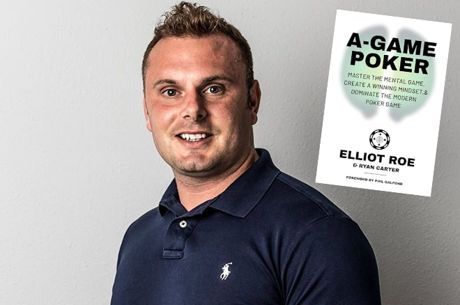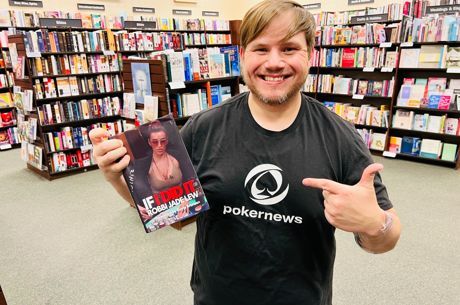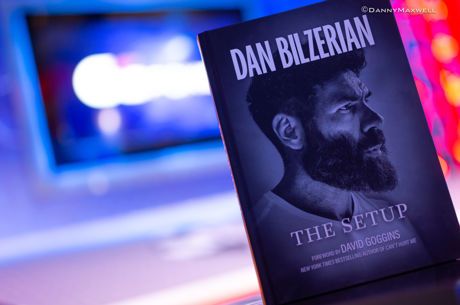PokerNews Book Review: "Thinking Tournament Poker" by Nate Meyvis

For the last 11 summers, Nate Meyvis’s Las Vegas trips have been filled with cards and conversation. The philosophy graduate student has cashed three times in the World Series of Poker Main Event, including finishing 98th in 2011. He has also enjoyed talking strategy — in the Rio, over dinner, between drinks — with other gifted poker minds.
“To go to the World Series,” Meyvis writes in his new book, Thinking Tournament Poker, “is to attend not only the largest poker series in the world but also to visit the largest ad hoc poker study convention in the world.”
The book, an annotated hand history of Day 1 of his 2014 WSOP Main Event, is similarly a dialogue between Meyvis and three accomplished poker pros: Andrew Brokos, Meyvis’s co-host on the Thinking Poker Podcast and an avid camper; Leo Wolpert, a WSOP bracelet winner and Jeopardy! contestant; and Gareth Chantler, a continent-hopping traveler, writer, and poker player.
After recording every hand that he played, Meyvis asked his trio of friends for advice. The result is a strategy resource that offers many expert opinions regarding a full day of tournament play.
This format is reminiscent of Winning Poker Tournaments One Hand at a Time, the three-volume series co-authored by Eric Lynch, Jon Turner, and Jon Van Fleet. A key difference is that Thinking Tournament Poker includes every single hand Meyvis entered — 46 of them — during his Day 1. Why? Because winning small and medium pots is crucial, notes Meyvis, and developing strategies for common spots is essential to success.
Like any good philosopher, Meyvis fears “unknown unknowns” — that is, mistakes that we can’t address because we don’t see them. “Long-held habits were costing me money, and these leaks would have remained in blind spots if I had filtered some of them out,” he writes.
These leaks aren’t “corrected.” Instead, through sustained analysis, disagreement, and conjecture, the group reveals a wealth of available information during a hand of tournament poker. They also frequently offer a series of reminders — Slow down. Think. Pay attention.
The book’s presentation is sparse (there are few, if any, graphics or charts) and essayistic. Readers familiar with the sometimes poorly written and edited genre of poker strategy books might be concerned. But Meyvis writes and thinks especially clearly, with the discussions consistently accessible and engaging even with the depth of commentary being provided.
For example, a hand analysis from early on Day 1 (blinds 100/200; most players still with around 30,000 chips), begins with the six-seat opening from early position for 450. The nine-seat calls, Meyvis calls on the button with 8x8x, and the big blind calls as well.
Flop (1,900): 9♠6♣6♦
The big blind checks, the raiser bets 850, and only Meyvis calls. “In a four-handed pot,” he writes, “the raiser is showing some extra strength by betting, and my hand doesn’t easily improve if I am behind, but I assessed that 8x8x was still too much hand to fold in position to a flop bet of less than half the pot.”
It is at this point Meyvis incorporates another opinion.
“Gareth stressed to me that it’s not obvious that 8x8x is too much hand to fold; he doesn’t hate the play, but thinks it requires argument. I thought, and still think, that raisers will bet this flop quite a lot with overcards and small pocket pairs, even in a four-handed pot. Moreover, even an early-position range figured to have enough unpaired hands and small pairs in it. Finally, my backdoor straight draw and two outs to a set are worth a little bit in this situation, especially since I will often be able to choose whether to check behind on the turn. Gareth thinks that the ability to raise a 10x or a 5x profitably on later streets would make the call particularly good.”
Turn (3,600): 9♠6♣6♦Q♠
The raiser checks. “I would have liked to fold out overcards, gutshots, and the like,” Meyvis continues, “but I was too far down in my range, and losing to too much of the raiser’s range, for there to have been value in betting.”
Meyvis assumes, rather than explains, the importance of range-oriented thinking. While the discussion isn’t nearly as dense as The Mathematics of Poker or Applications of No-Limit Hold ’em, readers will benefit from familiarity with concepts like balance, game theory, and range construction.
With a sense of where two eights falls within his range of holdings — and also how that range fares against his opponent’s early-position raising range — Meyvis decides to check behind.
River (3,600): 9♠6♣6♦Q♠7♣
After both players check the river, two eights beat ace-high. But did Meyvis miss a bet on the river?
“Some players will reliably value-bet enough hands better than mine that I can value-bet my 8x8x once it’s checked to me on the river,” he speculates. “In a tournament setting against an EP raiser in a pot that was 4-handed on the flop, however, he could easily simply have slowed down with a 9x or even 10x10x. Moreover, it was hard for me to represent a bluff by betting; I could have called the flop with 8x7x, but even that hand made a pair on the river. I didn’t think the raiser could call a bet with no pair or with an underpair to the board, and that removed the most plausible justification for betting 8x8x....”
The analysis concludes with a final thought from Brokos, who likes Meyvis’s play but also sees a case for having made a small (perhaps one-third pot) bet on the turn. Against savvy players who can take a bet-check-bet line as a bluff — which makes both a river call and a river fold uncomfortable — Brokos would prefer a small turn bet.
Most of the book reads similarly, with close attention to many small but important pots, detail-drenched analysis from Meyvis, and thoughtful counterpoints from Brokos, Wolpert, and Chantler.
At 70 pages, Thinking Tournament Poker covers only the early-to-middle tournament stages. There’s no bubble play, no ICM considerations, and no final table or short-handed discussion. Meyvis does mention that Day 2 will be chronicled in another volume, so a second installment (or more) may appear in the future. Let’s hope so.
Thinking Tournament Poker by Nate Meyvis is now available both and .
Ben Saxton is a teacher and a writer from upstate New York who has played small stakes poker, both live and online, since the early 2000s. Ben lives in New Orleans and covers poker on the Gulf Coast.
Want to stay atop all the latest in the poker world? If so, make sure to get PokerNews updates on your social media outlets. on Twitter and find us on both and !









